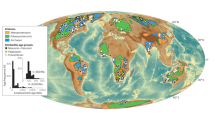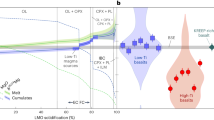Abstract
Kimberlite magmas have the deepest origin of all terrestrial magmas and are exclusively associated with cratons1,2,3. During ascent, they travel through about 150 kilometres of cratonic mantle lithosphere and entrain seemingly prohibitive loads (more than 25 per cent by volume) of mantle-derived xenoliths and xenocrysts (including diamond)4,5. Kimberlite magmas also reputedly have higher ascent rates6,7,8,9 than other xenolith-bearing magmas10,11. Exsolution of dissolved volatiles (carbon dioxide and water) is thought to be essential to provide sufficient buoyancy for the rapid ascent of these dense, crystal-rich magmas. The cause and nature of such exsolution, however, remains elusive and is rarely specified6,9. Here we use a series of high-temperature experiments to demonstrate a mechanism for the spontaneous, efficient and continuous production of this volatile phase. This mechanism requires parental melts of kimberlite to originate as carbonatite-like melts. In transit through the mantle lithosphere, these silica-undersaturated melts assimilate mantle minerals, especially orthopyroxene, driving the melt to more silicic compositions, and causing a marked drop in carbon dioxide solubility. The solubility drop manifests itself immediately in a continuous and vigorous exsolution of a fluid phase, thereby reducing magma density, increasing buoyancy, and driving the rapid and accelerating ascent of the increasingly kimberlitic magma. Our model provides an explanation for continuous ascent of magmas laden with high volumes of dense mantle cargo, an explanation for the chemical diversity of kimberlite, and a connection between kimberlites and cratons.
This is a preview of subscription content, access via your institution
Access options
Subscribe to this journal
Receive 51 print issues and online access
$199.00 per year
only $3.90 per issue
Buy this article
- Purchase on Springer Link
- Instant access to full article PDF
Prices may be subject to local taxes which are calculated during checkout




Similar content being viewed by others
References
Mitchell, R. H. Kimberlites: Mineralogy, Geochemistry and Petrology (Plenum, 1986)
Nixon, P. H. The morphology and nature of primary diamondiferous occurrences. J. Geochem. Explor. 53, 41–71 (1995)
Kjarsgaard, B. A. in Mineral Deposits of Canada: A Synthesis of Major Deposit-Types, District Metallogeny, The Evolution Of Geological Provinces, and Exploration Methods (ed. Goodfellow, W. D. ) 245–271 (Geological Association of Canada, Mineral Deposits Division, 2007)
Boyd, F. R. & Nixon, P. H. in Lesotho Kimberlites (ed. Nixon, P. H. ) 254–268 (Lesotho National Development Corporation, Maseru, 1973)
Mitchell, R. H. Petrology of hypabyssal kimberlites: relevance to primary magma compositions. J. Volcanol. Geotherm. Res. 174, 1–8 (2008)
Anderson, O. L. in Kimberlites, Diatremes and Diamonds: Their Geology, Petrology and Geochemistry (eds Meyer, H. O. A. & Boyd, F. R. ) 344–353 (AGU, 1979)
Canil, D. & Fedortchouk, Y. Garnet dissolution and the emplacement of kimberlites. Earth Planet. Sci. Lett. 167, 227–237 (1999)
Sparks, R. S. J. et al. Dynamical constraints on kimberlite volcanism. J. Volcanol. Geotherm. Res. 155, 18 (2006)
Wilson, L. & Head, J. W. An integrated model of kimberlite ascent and eruption. Nature 447, 53–57 (2007)
Sparks, R. S. J., Pinkerton, H. & Macdonald, R. The transport of xenoliths in magmas. Earth Planet. Sci. Lett. 35, 234–238 (1977)
Spera, F. K. Carbon dioxide in petrogenesis III: role of volatiles in the ascent of alkaline magma with special reference to xenolith-bearing mafic lavas. Contrib. Mineral. Petrol. 88, 217–232 (1984)
Sparks, R. S. J. et al. The nature of erupting kimberlite melts. Lithos 112, 429–438 (2009)
Price, S. E., Russell, J. K. & Kopylova, M. G. Primitive magma from the Jericho Pipe, N.W.T., Canada: constraints on primary kimberlite melt chemistry. J. Petrol. 41, 789–808 (2000)
Boyd, F. R. Compositional distinction between oceanic and cratonic lithosphere. Earth Planet. Sci. Lett. 96, 15–26 (1989)
Kopylova, M. G. & Russell, J. K. Chemical stratification of cratonic lithosphere: constraints from the Northern Slave craton, Canada. Earth Planet. Sci. Lett. 181, 71–87 (2000)
McDonough, W. F. Constraints on the composition of the continental lithospheric mantle. Earth Planet. Sci. Lett. 101, 1–18 (1990)
Mitchell, R. H. Composition of olivine, silica activity and oxygen fugacity in kimberlite. Lithos 6, 65–81 (1973)
Brett, R. C., Russell, J. K. & Moss, S. Origin of olivine in kimberlite: phenocryst or imposter? Lithos 112, 201–212 (2009)
Brooker, R. A., Sparks, R. S. J., Kavanagh, J. & Field, M. The volatile content of hypabyssal kimberlite magmas: some constraints from experiments on natural rock compositions. Bull. Volcanol. 73, 959–981 (2011)
Sparks, R. S. J., Brown, R. J., Field, M. & Gilbertson, M. A. Kimberlite ascent and eruption. Nature 450, E21 (2007)
Dalton, J. A. & Presnall, D. C. The continuum of primary carbonatitic-kimberlitic melt compositions in equilibrium with lherzolite: data from the system CaO-MgO-Al2O3-SiO2-CO2 at 6 GPa. J. Petrol. 39, 1953–1964 (1998)
Dobson, D. P. et al. In-situ measurement of viscosity and density of carbonate melts at high pressure. Earth Planet. Sci. Lett. 143, 207–215 (1996)
Keppler, H. Water solubility in carbonatite melt. Am. Mineral. 88, 1822–1824 (2003)
Lensky, N. G., Niebo, R. W., Holloway, J. R., Lyakhovsky, V. & Navon, O. Bubble nucleation as a trigger for xenolith entrapment in mantle melts. Earth Planet. Sci. Lett. 245, 278–288 (2006)
Luth, R. W. The activity of silica in kimberlites: revisited. Contrib. Mineral. Petrol. 158, 283–294 (2009)
Shaw, C. S. J. Dissolution of orthopyroxene in basanitic magma between 0.4 and 2 GPa: further implications for the origin of Si-rich alkaline glass inclusions in mantle xenoliths. Contrib. Mineral. Petrol. 135, 114–132 (1999)
Edwards, B. R. & Russell, J. K. Time scales of magmatic processes: new insights from dynamic models for magmatic assimilation. Geology 26, 1103–1106 (1998)
Wyllie, P. J. & Huang, W. L. Peridotite, kimberlite, and carbonatite explained in the system CaO-MgO-SiO2-CO2 . Geology 3, 621–624 (1975)
Canil, D. & Bellis, A. J. Phase equilibria in a volatile-free kimberlite at 0.1 MPa and the search for primary kimberlite magma. Lithos 105, 111–117 (2008)
Patterson, M., Francis, D. & McCandless, T. Kimberlites: magmas of mixtures? Lithos 112, 191–200 (2009)
Kavanagh, J. & Sparks, R. S. J. Temperature changes in ascending kimberlite magma. Earth Planet. Sci. Lett. 286, 404–413 (2009)
Dawson, J. B. Quaternary kimberlitic volcanism on the Tanzania Craton. Contrib. Mineral. Petrol. 116, 473–485 (1994)
Ferguson, J., Danchin, R. V. & Nixon, P. H. in Lesotho Kimberlites (ed. Nixon, P. H. ) 207–213 (Lesotho National Development Corporation, Maseru, Lesotho, 1973)
Hrma, P. Reaction between sodium carbonate and silica sand at 874°C < T 1022°C. J. Am. Ceram. Soc. 68, 337–341 (1985)
Kopylova, M. G., Russell, J. K. & Cookenboo, H. Petrology of peridotite and pyroxenite xenoliths from the Jericho kimberlite: implications for the thermal state of the mantle beneath the Slave Craton, Northern Canada. J. Petrol. 40, 79–104 (1999)
Dalton, J. A. & Presnall, D. C. Carbonatitic melts along solidus of model lherzolite in the system CaO–MgO–Al2O3–SiO2–CO2 from 3 to 7 GPa. Contrib. Mineral. Petrol. 131, 123–135 (1998)
Acknowledgements
We acknowledge the laboratory support of W. Ertel-Ingritsch and S. Laumann at Ludwig Maximilian University. Funding for this research is from the Natural Sciences and Engineering Research Council (J.K.R.), a Marie Curie outbound fellowship (L.A.P.) and an ERC Advanced Researcher Grant (D.B.D.). The original manuscript benefitted from review by S. Sparks.
Author information
Authors and Affiliations
Contributions
J.K.R. conceptualized the original idea, performed the static experiments at the University of Munich, and wrote the original draft paper. L.A.P. provided kimberlite expertise and context and drafted the figures. Y.L. performed the transient experiments and processed the experimental data. D.B.D. hosted, provided and repaired the experimental facility, and advised on the optimal experimental methods. All co-authors contributed to producing a final draft for review and in revising the manuscript after review.
Corresponding author
Ethics declarations
Competing interests
The authors declare no competing financial interests.
Supplementary information
Supplementary Information
This file contains Supplementary Tables 1-2. (PDF 122 kb)
Rights and permissions
About this article
Cite this article
Russell, J., Porritt, L., Lavallée, Y. et al. Kimberlite ascent by assimilation-fuelled buoyancy. Nature 481, 352–356 (2012). https://doi.org/10.1038/nature10740
Received:
Accepted:
Published:
Issue Date:
DOI: https://doi.org/10.1038/nature10740
This article is cited by
-
Genesis and evolution of kimberlites
Nature Reviews Earth & Environment (2023)
-
Rift-induced disruption of cratonic keels drives kimberlite volcanism
Nature (2023)
-
Transport and eruption of mantle xenoliths creates a lagging problem
Communications Earth & Environment (2023)
-
Diamond preservation in the lithospheric mantle recorded by olivine in kimberlites
Nature Communications (2023)
-
Melt stripping and agglutination of pyroclasts during the explosive eruption of low viscosity magmas
Nature Communications (2022)
Comments
By submitting a comment you agree to abide by our Terms and Community Guidelines. If you find something abusive or that does not comply with our terms or guidelines please flag it as inappropriate.



